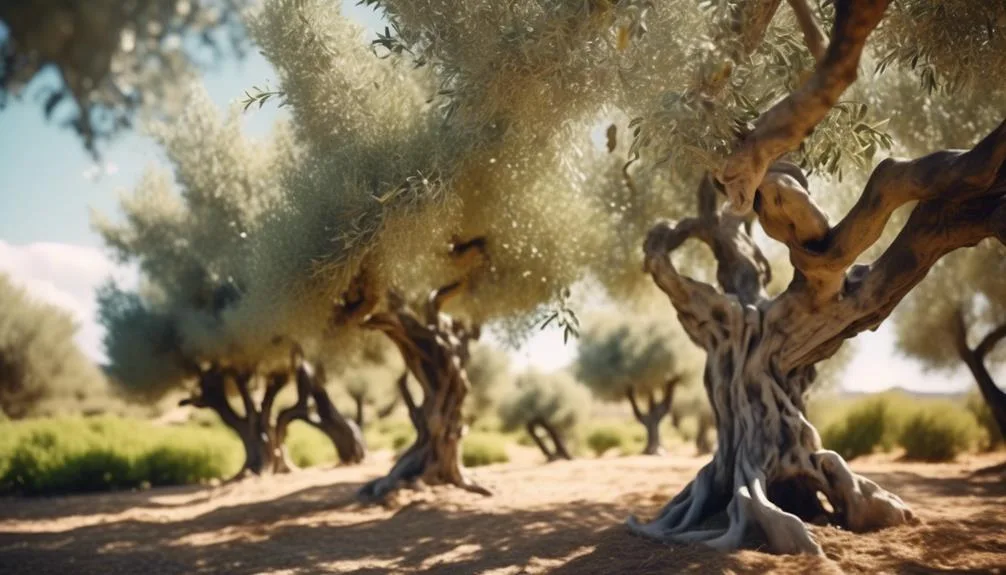Wild olive trees can be found in various stunning locations worldwide, from the Mediterranean to national parks. These beautiful trees thrive in diverse environments, offering unique charm for nature lovers and those in search of tranquility.
Whether you're a nature enthusiast or simply seeking a peaceful escape, the hunt for wild olive trees is an adventure worth undertaking.
Key Takeaways
- The Mediterranean region is known for its diverse landscapes and is the perfect habitat for wild olive trees.
- National parks serve as sanctuaries for wildlife and outdoor enthusiasts, and often have ancient olive groves.
- Wild olive orchards preserve ancient agricultural practices and support diverse ecosystems and habitats.
- Botanical gardens contribute to the conservation of olive tree species and offer educational experiences for visitors.
Mediterranean Regions
In the Mediterranean regions, you'll discover a rich tapestry of diverse landscapes, from sun-drenched coastlines to rugged mountain ranges, providing the perfect habitat for the elusive wild olive trees.
Olive tree cultivation has been a fundamental part of Mediterranean agriculture for thousands of years, with the region being renowned for its production of high-quality olives and olive oil. The olive tree holds significant symbolism in Mediterranean culture, representing peace, wisdom, and prosperity. Its resilient nature and longevity also symbolize endurance and strength.
The cultivation of olive trees is deeply ingrained in the Mediterranean way of life, shaping not only the landscape but also the traditions and customs of its people. As you explore the Mediterranean, you'll find yourself immersed in the timeless beauty and cultural significance of the olive tree.
National Parks
Amidst the rugged beauty of the Mediterranean landscapes, you'll encounter national parks teeming with diverse flora and fauna, offering a sanctuary for wildlife and a haven for outdoor enthusiasts. These national parks play a vital role in conservation efforts, preserving the stunning natural environment and protecting endangered species.
As you explore these parks, you'll be immersed in the breathtaking beauty of ancient olive groves, towering pine trees, and vibrant wildflowers. The parks provide a refuge for elusive wildlife such as eagles, wild boars, and deer. Trails wind through the lush forests, leading to spectacular viewpoints and hidden waterfalls.
Wild Olive Orchards
Among the rugged Mediterranean landscapes, wild olive orchards offer a captivating display of ancient trees and rich biodiversity. Olive tree cultivation in these orchards dates back centuries, and the environmental impact is a crucial aspect to consider. The cultivation of olive trees in these orchards not only preserves ancient agricultural practices but also supports the ecosystem by providing habitats for various species. Here's a glimpse of what you might find in these enchanting orchards:
| Ancient Trees | Biodiversity | Serene Beauty |
|---|---|---|
| Twisted trunks | Diverse wildlife | Peaceful atmosphere |
| Silver-green leaves | Wildflowers | Scenic vistas |
| Fragrant blossoms | Songbirds | Tranquil surroundings |
Exploring wild olive orchards not only provides a serene escape but also a deeper understanding of the interconnectedness between olive tree cultivation and the environment.
Botanical Gardens
As you step into a botanical garden, the vibrant array of flora and the harmonious blend of scents instantly captivate your senses, offering a delightful immersion into the world of plant diversity.
Botanical gardens serve as invaluable resources for tree identification, showcasing a wide variety of olive tree species and other plant life. The carefully curated collections provide a unique opportunity to learn about different types of wild olive trees, their characteristics, and the habitats they thrive in.
Moreover, botanical gardens play a crucial role in conservation efforts, preserving rare and endangered olive tree species. By educating visitors and conducting research, these gardens contribute to the protection and sustainable management of wild olive trees and their ecosystems.
Visiting a botanical garden not only offers a visual feast but also an educational experience, shedding light on the importance of safeguarding our natural heritage.
Coastal Areas
Exploring coastal areas provides a unique opportunity to encounter wild olive trees thriving in their natural habitats, continuing your journey of discovering the diverse and resilient nature of these remarkable plants.
Wild olive trees play a crucial role in erosion control along coastlines, their extensive root systems helping to stabilize soil and prevent land loss due to wave action and tidal forces.
Additionally, these coastal habitats serve as important areas for biodiversity conservation, with wild olive trees providing shelter and sustenance for various species of birds, insects, and small mammals.
The salty sea air and sandy soils create a unique environment where wild olive trees demonstrate their adaptability and tenacity, showcasing their ability to thrive in challenging coastal conditions while contributing to the preservation of delicate coastal ecosystems.
Conclusion
As you explore the Mediterranean regions, national parks, and coastal areas, keep an eye out for the majestic wild olive trees.
Whether in the wild, orchards, or gardens, these stunning trees are a true treasure of nature.
Happy hunting!

